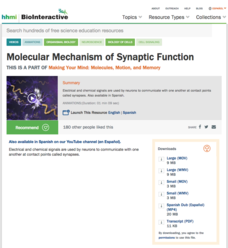Howard Hughes Medical Institute
Molecular Mechanism of Synaptic Function
Neurons don't touch each other, but they still communicate. Observe the process of both electrical and chemical signals used by neurons to share information. Hear exactly what triggers each step of the reaction as you view an animation...
PBS
How Two Microbes Changed History
Where would we be without bacteria? As it turns out, we owe them everything! Introduce young biologists to endosymbiotic theory using an amazing video from an extensive biology playlist. Scholars discover the bacteria that may be...
Curated OER
Anatomy of a Muscle Cell
Previous videos have dealt with the proteins that produce mechanical motion and how nerves stimulate contraction. But this presentation explains on a gross anatomical scale, how skeletal muscle is structured.
Curated OER
Human Genome
Welcome to the complex biological story that is our life. Great visual imagery zooms in on the dissection of a DNA double helix in our body. What happens with RNA? Where do amino acids come in? This resource explores our inner workings...
Howard Hughes Medical Institute
Molecular Activity in Aplysia Short-Term Memory
Scientists have yet to find the limit on the human brain's capacity for memory storage, so the potential is limitless! An animated video demonstrates how the brain places information in short-term memory. Viewers observe the importance...
Curated OER
Mutations
The basics of mutation types and some potential effects of those are described and diagrammed here. Each detail is very clear and includes the labels and translation change exhibited. A great slideshow to expand on DNA replication issues.
Curated OER
Cancer
It is fascinating to learn about apoptosis and the fact that cells are able to destroy themselves without any external influence. Sal creates interest in the huge number of cells and the complexity of the human body. The likelihood of a...
Curated OER
DNA Basics, Bacterial Cell Walls
Some basic descriptions of DNA and the appearance of structures in a bacteria are included along with great diagrams. The presentation has clear, but detailed slides, and your students will find the information about Gram staining easy...
Curated OER
DNA: The Genetic Material
The various experiments and processes that were completed in the 20th century to further our understanding of DNA are summarized here. There are wonderful slides to popularize the scientists who dedicated their professional life to...
Socratica
What Is Biochemistry?
Watch as chemistry comes alive! Socratica's biology playlist kicks off with a simple video detailing the principle components of biochemistry. Content includes carbohydrates, proteins, and nucleic acids. The narrator describes each class...
Curated OER
Control of Prokaryotic (Bacterial) Genes
A nicely formatted set of slides that logically follow and define the structure and function of the genes in Bacteria. The repressor proteins and other gene regulators are listed and diagrams support the explanations of their function on...
PBS
When Insects First Flew
Insects developed wings and the ability to fly earlier than any other animal—when exactly did that happen? Scientists know this fact but struggle to explain when insect wings developed and how this entirely new structure appeared. PBS...
Howard Hughes Medical Institute
Repellant Ephrin Signals Guide Limb Innervations
The foot bone connects to the leg bone, but how? Learn about how neurons grow in the proper direction thanks to signalling. Observe what happens when they encounter a repulsive ephrin signal and the correction process that takes place.
Howard Hughes Medical Institute
Neurons in Parietal Cortex Are Active During Straddling
How do scientists know which parts of the brain various functions use? With the help of an animated cat, viewers observe this process. They listen to the activity of one neuron as the cat steps over an obstacle and hear when the neuron...
Curated OER
Chemistry of Carbon - Building Blocks of Life
A great review of the structure and function of carbon-based molecules important to life, especially with relevance to humans. The chemistry behind the combination of polymers and the breakdown of bonds is covered. Valuable content in...
Howard Hughes Medical Institute
Measuring Circadian Activity in Drosophila
How many hours should be in a day? One species of drosophila naturally prefers a 24.5 hour day, while another strongly prefers a 19-hour day. An animation and graph share data from each of these species when exposed to the typical light...

















